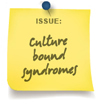Culture-bound Syndromes
Pre Course Reading for CALD 9
eCALD Supplementary Resources

The Diagnostic and Statistical Manual of Mental Disorders (DSM V) or the International Statistical Classification of Diseases and Related Health Problems (ICD-10) (American Psychiatric Association (APA), 2013a; WHO, 1992) includes information on cultural concepts in order to improve the accuracy of diagnosis and the comprehensiveness of clinical assessment. Clinical assessment of clients presenting with these cultural concepts should determine whether they meet DSM V criteria for a specified disorder or another specified or unspecified diagnosis. Once the disorder is diagnosed the cultural terms and explanations should be included in case formulations; they may help clarify symptoms and aetiological attributions that could otherwise be confusing. Clients whose symptoms do not meet DSM criteria for a specific mental disorder may still expect and require treatment; this should be assessed on a case-by-case basis. In addition to the Cultural Formulation Interview (CFI) and its supplementary modules, DSM V contains the following information and tools that may be useful when integrating cultural information in clinical practice (APA 2013a; 2013b; 2013c; 2013d):
- Data in DSM V criteria and text for specific disorders: The text includes information on cultural variations in prevalence, symptomatology, associated cultural concepts and other clinical aspects. It is important to emphasize that there is no one-to-one correlation at the categorical level between DSM disorders and cultural concepts. Differential diagnosis for individuals must therefore incorporate information on cultural variation with information elicited by the CFI.
- Other Conditions That May Be a Focus of Clinical Attention: Some of the clinical concerns identified by the CFI may correspond to V codes or Z codes—for example, acculturation problems, parent-child relational problems, or religious or spiritual problems.
- Glossary of Cultural Concepts of Distress: Located in the Appendix and this glossary provides examples of well-studied cultural concepts of distress that illustrate the relevance of cultural information for clinical diagnosis and some of the interrelationships among cultural syndromes, idioms of distress and causal explanations.
Understanding the cultural context of illness experience is essential for effective diagnostic assessment and clinical management. Cultures are open, dynamic systems that undergo continuous change over time. In the contemporary world most individuals and groups are exposed to multiple cultures which they use to fashion their own identities and make sense of experience. These features of culture make it crucial not to overgeneralise cultural information or stereotype groups in terms of fixed cultural traits (DSM V, 2013a).
See next page for the list and descriptions of Culture-Bound Syndromes that occur in African, Asian and Middle Eastern cultures.
